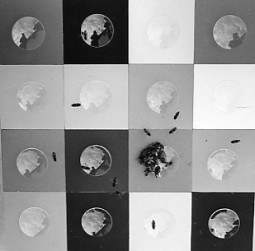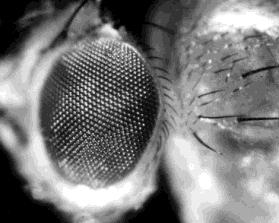
| Index to this page |
The arthropod (e.g., insects, crustaceans) eye is built quite differently from the vertebrate eye (and mollusk eye).
| (Despite their structural differences, both insect and vertebrate eyes depend on related genes for their development. Link to a discussion.) |
Arthropod eyes are called compound eyes because they are made up of repeating units, the ommatidia, each of which functions as a separate visual receptor.

Each ommatidium consists of
The pigment cells ensure that only light entering the ommatidium parallel (or almost so) to its long axis reaches the visual cells and triggers nerve impulses. Thus each ommatidium is pointed at just a single area in space and contributes information about only one small area in the field of view.

There may be thousands of ommatidia in a compound eye with their facets spread over most of the surface of a hemisphere. (The photo, courtesy Carolina Biological Supply Company, shows the compound eye of Drosophila melanogaster.)
The composite of all their responses is a mosaic image — a pattern of light and dark dots rather like the halftone illustrations in a newspaper or magazine. And just as in those media, the finer the pattern of dots, the better the quality of the image.
Grasshopper eyes, with relatively few ommatidia must produce a coarse, grainy image. The honeybee and dragonfly have many more ommatidia and a corresponding improvement in their ability to discriminate ("resolve") detail. Even so, the resolving ability of the honeybee eye is poor in comparison with that of most vertebrate eyes and only 1/60 as good as that of the human eye; that is, two objects that we could distinguish between at 60 feet (18 m) could only be discriminated by the bee at a distance of one foot (0.3 m).
| Link to illustrated discussion of honeybee navigation. |
Arthropods that are apt to be active in dim light (e.g., crayfish, praying mantis) concentrate the screening pigments of their ommatidia into the lower ends of the pigment cells. This shift enables light entering a single ommatidium at an angle to pass into adjacent ommatidia and stimulate them also. With many ommatidia responding to a single area in the visual field, the image becomes coarser. The praying mantis probably can do little more than distinguish light and dark in the evening.
The shift in pigments does, however, make it more sensitive to light than it is in the daytime as more ommatidia can detect a given area of light.
 |
| A demonstration of color vision in honeybees. After a period of feeding from a dish placed on blue cardboard, the bees return to an empty dish on a clean blue card. They are able to distinguish the blue card from others of varying shades of gray. (Courtesy of Dr. M. Renner.) |
In the honeybee,
Television camera tubes are also sensitive to ultraviolet, as well as visible light, but their glass lens is opaque to ultraviolet. (This is why you can't get tanned — or synthesize calciferol — from the sunlight passing through window glass.)
Using a special ultraviolet-transmitting lens, Eisner and his coworkers at Cornell have demonstrated that many insect-pollinated flowers appear to the honeybee quite different from the way they appear to us. The sharp contrasts between flowers that appear similar to us partly explains the efficiency with which honeybees secure nectar from only one species of flower at a time even when other species are also in bloom.
 |  |
The photos (courtesy of Dr. Eisner) show a blackeyed susan photographed in visible light (left) and under ultraviolet light (right).
Monarch butterflies, which can migrate as much as 2500 miles (> 4000 km), navigate by ultraviolet light from the sun. When their view of the sun is through a filter that blocks out only its ultraviolet rays, their flight path becomes disoriented.
Ultraviolet vision is not limited to animals with compound eyes. A few marsupials, rodents, a bat that feeds on nectar, and many birds have also been shown to have ultraviolet vision.
| Welcome&Next Search |